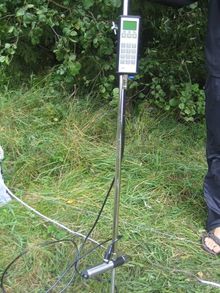Difference between revisions of "Discharge - Ott ADC"
Jump to navigation
Jump to search
m |
m (→Disadvantages:) |
||
| (7 intermediate revisions by 3 users not shown) | |||
| Line 1: | Line 1: | ||
| + | {| align="right" | ||
| + | |[[Image:ADC.JPG|right|220px|ADC]] | ||
| + | |} | ||
| + | |||
| + | |||
==Parameter to be measured:== | ==Parameter to be measured:== | ||
Flow velocity (, discharge) | Flow velocity (, discharge) | ||
| Line 21: | Line 26: | ||
==Disadvantages:== | ==Disadvantages:== | ||
* heavy rods with coarse scale | * heavy rods with coarse scale | ||
| − | |||
* test device showed signs of rainwater entering the display | * test device showed signs of rainwater entering the display | ||
* built-in batteries, cannot be changed by user | * built-in batteries, cannot be changed by user | ||
| − | |||
==What to watch out for:== | ==What to watch out for:== | ||
| − | * | + | * turbulent flow can cause the device to reject the measurements. Newer versions of the firmware provide (apart form additional quality check features) options to control that - look for new versions on the OTT-website |
| + | * back pain (when adjusting depth of the probe free-hanging) - use sliding rod or makeshift additional support for holding the rod | ||
| + | * the wall charger seems to use more than 12 V put on a standard mini-USB plug - rather don't try to charge standard devices with that power supply! | ||
| + | ==Links== | ||
| + | [[ Discharge - comparison of measurements (C2, Flowtracker, Flowsens, ADC, tracer, dipping rod) ]] | ||
| − | |||
Other related web sites: | Other related web sites: | ||
| − | |||
Projects that used the above equipment: | Projects that used the above equipment: | ||
Latest revision as of 11:39, 19 September 2016
Parameter to be measured:
Flow velocity (, discharge)
Method:
ultrasonic reflectogram cross-correlation
Equipment:
- probe
- display unit
- wading rod
Advantages:
- on-site discharge computation
- powerful quality checking, configuration and data storage options
- integrated depth measurement and sensor positioning indicator
- convenient software with visualisation capabilities
- USB (no serial port required)
- rechargable via USB
Disadvantages:
- heavy rods with coarse scale
- test device showed signs of rainwater entering the display
- built-in batteries, cannot be changed by user
What to watch out for:
- turbulent flow can cause the device to reject the measurements. Newer versions of the firmware provide (apart form additional quality check features) options to control that - look for new versions on the OTT-website
- back pain (when adjusting depth of the probe free-hanging) - use sliding rod or makeshift additional support for holding the rod
- the wall charger seems to use more than 12 V put on a standard mini-USB plug - rather don't try to charge standard devices with that power supply!
Links
Discharge - comparison of measurements (C2, Flowtracker, Flowsens, ADC, tracer, dipping rod)
Other related web sites:
Projects that used the above equipment: -
References
http://www.ott-hydrometry.de/web/ott_de.nsf/id/pa_adc_e.html
